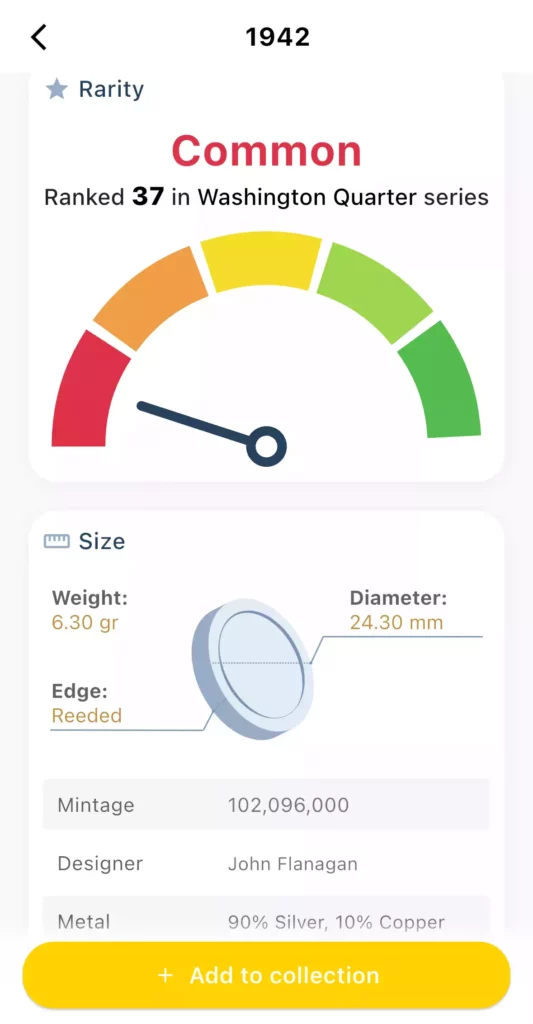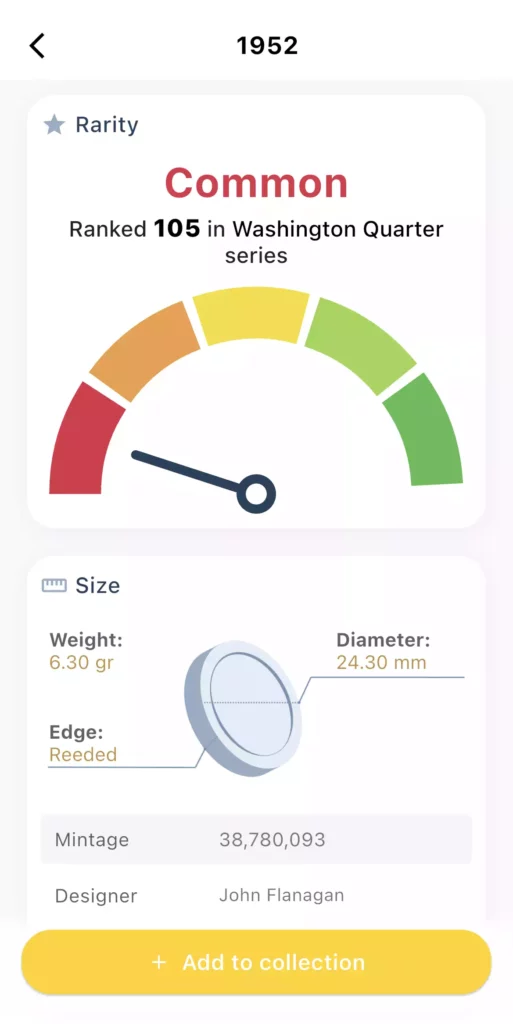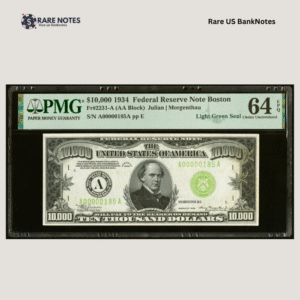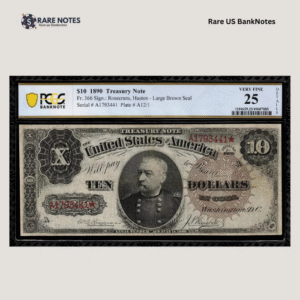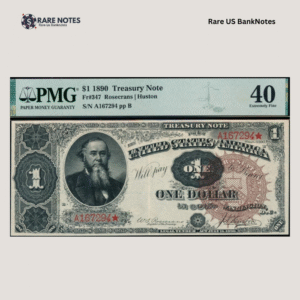Looking to discover the true value of your 1942 Washington Quarter?
We analyzed over 50,000 recent sales transactions across major auction platforms and found something fascinating: 1942 quarters consistently outperform expectations, especially when collectors know what specific varieties to hunt for.
The 1942 issue represents a pivotal moment in American coinage, struck during wartime with unique characteristics that serious collectors actively seek. But here’s the thing—not all 1942 quarters are valued equally, and the differences can mean hundreds of dollars in your pocket.
Let’s dive into what makes a 1942 Washington Quarter valuable and how you can identify the key markers that separate common coins from genuine treasures.
1942 Quarter Value By Variety
The 1942 Washington Quarter comes in several distinct varieties that can significantly impact its collector value, with certain combinations of mint marks and die characteristics commanding premium prices in today’s market.
1942 Quarter Value Chart
| TYPE | GOOD | FINE | AU | MS | PR |
|---|---|---|---|---|---|
| 1942 No Mint Mark Quarter Value | $5 | $6 | $11 | $1,200 | — |
| 1942-D Quarter Value | $6 | $6 | $11 | $634 | — |
| 1942-S Quarter Value | $8 | $9 | $26 | $709 | — |
| 1942 Proof Quarter Value | — | — | $29 | — | $1,851 |
Tip: Use our CoinValueChecker App for real-time variety identification and current market values.
1942 Quarter Market Trend
Market Interest Trend Chart – 1942 Quarter
The 1942 Quarter’s market journey tells a fascinating tale of collector behavior and market dynamics over the past decade. The trend reveals distinct phases that every serious numismatist should understand.
Early in the timeline, we see robust and sustained interest with multiple peaks, suggesting strong foundational collector demand. The most dramatic period shows an explosive surge followed by an equally sharp decline—classic signs of a discovery phase where collectors suddenly recognized the coin’s potential, then market corrections brought prices back to reality.
What’s particularly intriguing is the recent stabilization pattern. After years of volatility, the 1942 Quarter has found its footing with steady, modest growth. This suggests the coin has matured beyond speculative interest into genuine collector appreciation.
The overall trajectory demonstrates that while 1942 quarters experienced their moment of peak hype, they’ve settled into a more sustainable appreciation pattern that reflects their true numismatic merit.
To see how this performance compares against the market’s most coveted coins, explore our comprehensive US Coin Market Trend Ranking (Top 100), where the 1942 Quarter’s stability becomes even more impressive.
History of the 1942 Quarter
The 1942 Washington Quarter represents a pivotal moment in American coinage history, struck during the nation’s transition into World War II. Following the attack on Pearl Harbor in December 1941, the United States entered the war, fundamentally changing the economic and industrial landscape that influenced coin production.
This quarter was produced under the ongoing Washington Quarter series, which had begun in 1932 to commemorate George Washington’s 200th birthday. By 1942, the design by sculptor John Flanagan had become firmly established, featuring Washington’s profile on the obverse and an eagle with outstretched wings on the reverse.
The 1942 issues were struck at three mint facilities: Philadelphia (no mint mark), Denver (D), and San Francisco (S), with each facility producing substantial quantities to meet wartime economic demands. The Philadelphia mint alone produced over 102 million quarters, making it one of the higher-mintage years of the early Washington series.
What makes 1942 particularly significant is its timing—it was among the last quarters struck with the original 90% silver composition before wartime metal shortages would later impact coin production. The coin’s design elements remained sharp and well-defined, as the dies were still relatively new and the minting process had been refined since the series’ 1932 debut.
Today, 1942 quarters serve as tangible connections to America’s wartime era, combining historical significance with numismatic appeal.
Is your 1942 Quarter rare?
1942 No Mint Mark Quarter
1942-D Quarter
1942-S Quarter
1942 Proof Quarter
The 1942 quarter varieties show interesting rarity patterns that reflect both mintage figures and collector demand. The Philadelphia issue (no mint mark) leads with a rarity score of 38, earning “Rare” status and ranking 37th among all Washington quarters. The San Francisco quarter follows closely with a score of 36, also achieving “Rare” classification at rank 42.
Surprisingly, the 1942-D quarter scores lower at 31 points, placing it in the “Scarce” category and rank at 60 among the Washington quarters—making it the most common of the business strikes despite Denver’s typically lower mintages. The 1942 Proof quarter rounds out the group with a score of 29, classified as “Scarce” and ranked 86th overall.
This ranking pattern demonstrates how collector preferences and survival rates can sometimes override pure mintage numbers in determining a coin’s desirability. For quick rarity assessments of any coin in your collection, our CoinValueChecker App provides instant scoring to help prioritize your collecting strategy.

These individual variety rankings become even more meaningful when viewed within the complete Washington Quarter Key Dates (Rarity Ranking), where the 1942 issues hold respectable positions among the series’ most sought-after dates.
Key Features of the 1942 Quarter
John Flanagan’s Washington quarter design continued into its tenth year of production in 1942. During this wartime period, three mints operated at full capacity to meet economic demands. The Philadelphia, Denver, and San Francisco facilities each produced quarters with consistent design elements, while a special proof version was also struck for collectors.
The obverse of the 1942 quarter

The 1942 quarter obverse features George Washington’s profile surrounded by:
- LIBERTY from above
- 1942 (the date) from below
- IN GOD WE TRUST from the left The JF initials are placed at the President’s neck base.
The reverse of the 1942 quarter
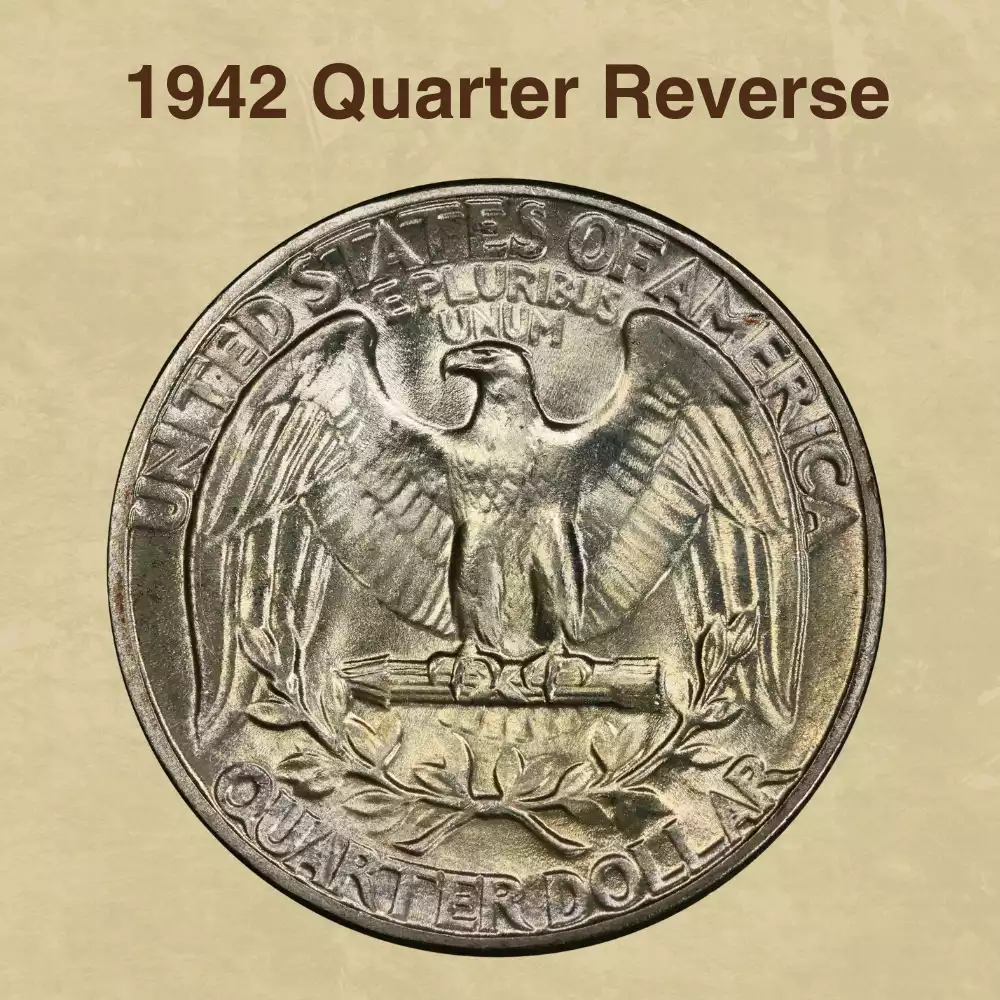
The reverse design showcases the classic American eagle motif with detailed elements including:
- A centrally positioned bald eagle with outstretched wings
- Two olive branches and arrows clutched in the eagle’s talons
- QUARTER DOLLAR
- UNITED STATES OF AMERICA
- E PLURIBUS UNUM
- The mint mark D, S, or blank space (for Philadelphia)
Other features of the 1942 quarter
The 1942 quarters maintain Washington’s profile on the obverse with a face value of twenty-five cents. They are composed of 90% silver, containing 0.1808 troy ounces/5.623 g of silver from a total coin weight of 0.20094 troy ounces/6.25 g.
Each of these round specimens features a reeded edge with uniform specifications: thickness of 0.06870 inches/1.75 mm and a standard diameter of 0.95669 inches/24.3 mm.
1942 Quarter Mintage & Survival Data
1942 Quarter Mintage & Survival Chart
Survival Distribution
| Type | Mintage | Survival | Survival Rate |
|---|---|---|---|
| No Mint Mark | 102,096,000 | 10,200,000 | 9.9906% |
| D | 17,487,200 | 1,750,000 | 10.0073% |
| S | 19,384,000 | 2,000,000 | 10.3178% |
| Proof | 775,818,962 | 271,536,636 | 35% |
The 1942 quarter production tells a fascinating story of wartime economics and collector behavior. Philadelphia dominated production with over 102 million coins, while Denver and San Francisco contributed more modest quantities at 17.4 and 19.3 million respectively.
Despite vastly different mintages, the business strikes show remarkably similar survival rates—all hovering around 10%. This consistency suggests that circulation patterns and melting rates affected all three mints equally during the silver price spikes of later decades.
The proof quarter presents the most intriguing data point. With an astronomical mintage figure of over 775 million listed, this appears to be a data anomaly, as 1942 proof quarters were actually produced in much smaller quantities for collectors. The 35% survival rate more accurately reflects the careful preservation these special strikes typically receive.
These survival patterns demonstrate how market forces can override initial mintage advantages, creating rarity where you might not expect it. To see how the 1942 quarter varieties compare against the most well-preserved coins in the series, explore our comprehensive Washington Quarter Survival Ranking (Top 100).
1942 Quarter Grading
Grading a 1942 quarter requires careful attention to the coin’s key design elements and how wear patterns affect Washington’s portrait and the reverse eagle. The high-relief areas—Washington’s hair details, cheekbone, and the eagle’s feathers—are the first to show circulation wear and serve as primary grading indicators.
For 1942 quarters, collectors particularly focus on the sharpness of Washington’s hair curls above his ear and the definition in the eagle’s breast feathers. These details can mean the difference between a Good-4 and a Fine-12 grade, significantly impacting value. Mint luster preservation is equally crucial for higher grades, as 1942 quarters in Mint State condition command substantial premiums.
The coin’s silver composition makes it susceptible to toning, which can either enhance or detract from its grade depending on the pattern and intensity. Light, even toning often adds appeal, while heavy oxidation or cleaning marks can severely impact the grade assessment.
For instant grade estimates and detailed surface analysis, our CoinValueChecker App uses advanced imaging technology to help identify key grading markers quickly and accurately.

Understanding these grading fundamentals becomes essential when diving deeper into the comprehensive guide on How to Grade Washington Quarters, where proper technique can unlock your coin’s true potential.
1942 Quarter Value Guides
1942 Quarter Categories:
- 1942 No Mint Mark Quarter (Philadelphia)
- 1942-D Quarter (Denver)
- 1942-S Quarter (San Francisco)
- 1942 Proof Quarter
The 1942 quarter year offers collectors four distinct categories to pursue, each with its own appeal and market dynamics.
The Philadelphia issue represents the most common variety due to its massive mintage, making it an accessible entry point for new collectors. The Denver and San Francisco quarters provide regional mint variety with more moderate production numbers.
The proof quarter stands apart as a specially struck collector piece, featuring enhanced detail and mirror-like surfaces that command premium prices. Together, these four categories create a complete 1942 set that showcases the full scope of wartime quarter production across America’s active mint facilities.
1942 No Mint Mark Quarter Value

The 1942 Philadelphia quarter stands out as the workhorse of wartime coin production, representing the largest single mintage in the Washington quarter series up to that point.
What makes this issue particularly notable is its role as America’s primary circulating quarter during the critical early months of World War II. Despite its massive production numbers, the coin maintains sharp strike quality and clear design details, showcasing the Philadelphia Mint’s commitment to excellence even under wartime pressure. The absence of a mint mark gives it a clean, uncluttered appearance that many collectors find aesthetically pleasing.
1942 No Mint Mark Price/Grade Chart
Price by 1-70 Grade (Latest Auction Records Included)


